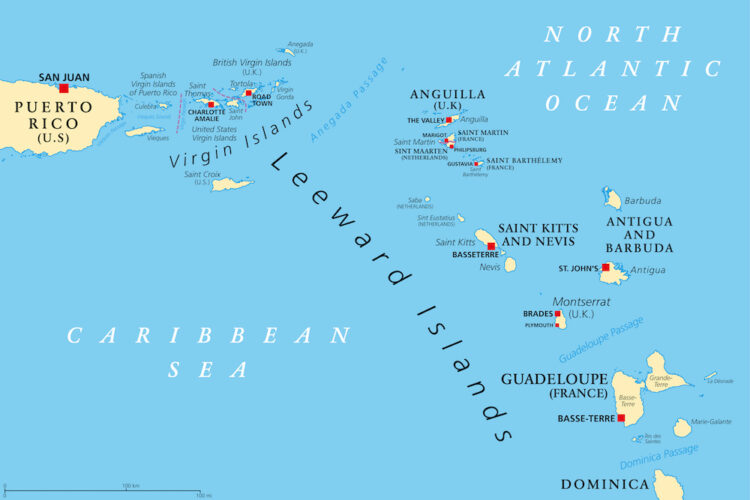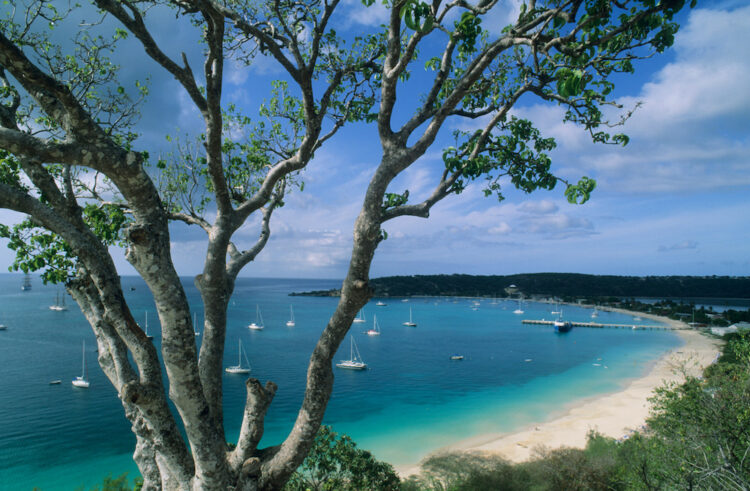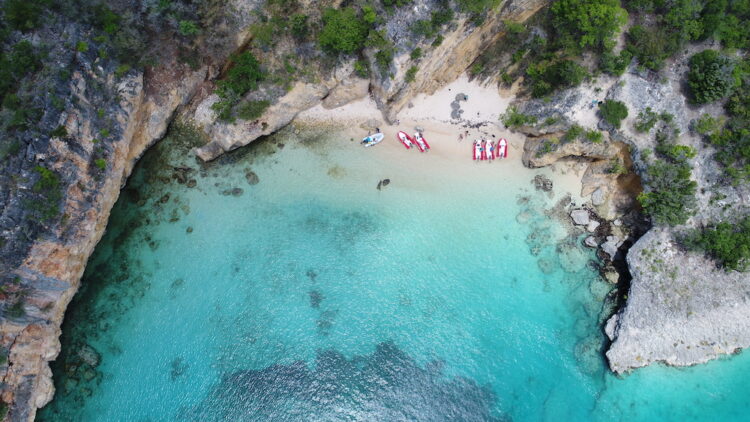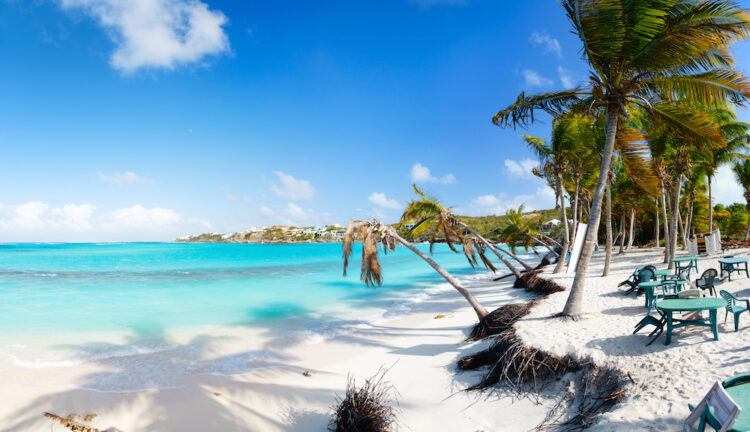Who comes to love Anguilla? Much is made of the rich and famous who come to this island haven to hide in plain sight, to mingle undisturbed. But for every celebrity, there are the thousands of visitors every year who come for the warm hospitality of the people, the brilliance of the beaches, and the quiet, idyllic return to a more elegant, simple, yet rich existence.

Anguilla is the northernmost of the Leeward Islands. It is situated 146 miles east of Puerto Rico and eleven miles north of St. Martin/St. Maarten. The island is sixteen miles long and three miles wide at its widest point. In total, the land mass measures 35 square miles (91 sq km). There are more than 40 miles (64 km) of coastline on which its many spectacular beaches are situated. Anguilla is a mostly flat island, with its highest point at 213 feet above sea level. The island does not have any natural rivers, streams, or lakes, but several large salt ponds dot the landscape.
The sea and boating have naturally played an important part in the island’s culture and traditions. Numerous fishing villages, like the ones at Crocus Bay and Island Harbour, embody centuries of Anguilla’s maritime history and nautical traditions. So ingrained is the love of the sea that boat racing is the national sport. The unique Anguilla boats and boat racing extravaganzas are the product of a bond with the sea that is as deep as the waters that cover the ocean floor.
The island is largely Christian in denomination. English holidays such as the Queen’s Birthday, Whit Monday, and others are celebrated, but English-speaking Anguilla maintains a unique balance of all the historical influences that make this island a truly individual nation.
Anguilla’s fortunate location in the Leeward Islands means that for much of the year, there is a constant breeze cooling the air and affording very little rainfall or humidity. The subtropical climate and temperature tend to be constant year-round, averaging 80 degrees Fahrenheit. Annual rainfall is typically 35 inches, with the “rainy season” running from August through November. As a location in the Northern Hemisphere, the seasons in Anguilla are the same as in the United States: when it is winter in the United States, it is winter in Anguilla. However, the difference is that the temperature and rainfall in Anguilla are nearly constant year-round. When there is snow on the ground in Boston, it’s a wonderful 80 degrees in Anguilla! Winter is Anguilla’s high season. As the temperatures fall in the United States and Europe, tourists travel to the island’s warm tropical beaches. When the busy winter (November – May) travel season is over, savvy travelers know that the best days to travel are just ahead. The period April to November is referred to as the Summer Season. During the summer, the island experiences a true value season as hotels and tour operators provide special programs and rates for couples, families, groups, etc., to accommodate the smaller number of visitors.

Anguilla is an easy island to explore. One major road runs from the East End to the West End, with smaller roads branching off. Whether seeing the island by taxi, bike, scooter, or car, there is always a beautiful beach; a restaurant, café, or barbecue with sumptuous fare; an art gallery, museum, or boutique; a harbor dotted with brightly colored ‘Anguilla’ boats; a breathtaking vision of architectural resort styles that include Moorish, Mediterranean, and modern designs just ‘up the road’ from charming and, colorful West Indian hotels, resorts, and private homes.
Each of Anguilla’s beaches is open to the public – visitors can take their pick of all or stay with their favorite during their time on the island. Beach-hopping is a favored pastime of visitors who relish sampling long ribbons of quiet and serene white sands, picturesque coves, beaches ringing harbor waters dotted with colorful fishing boats, beaches where bistros and the sounds of live music fill the air, beaches overlooked by one of the many fine dining establishments where a beach stroller can come out of the sun for haute cuisine. Not all of the beaches are swimming and water sports locations. Many are isolated and secluded nature spots where goats, iguanas (sporadic sightings), and protected sea turtles outnumber human visitors.

Throughout the island, a visitor will encounter the simple yet elegant architecture of the Anguillian people. You will want to take special notice of the shops painted lime green or pink or a school of aquamarine. Of special note are the churches, nearly one church for every two square miles of the island. Situated in the center of Anguilla is The Valley, the nation’s capital. In recent years the shopping and dining experience in The Valley has increased. The eateries and restaurants that dot the streets of The Valley include the Koal Keel Restaurant. The police station, government offices, courthouse, and parliamentary buildings are all located here, as well. The Historic District has many picturesque churches and private homes. Miss Marjorie Hodge’s Homestead and the Warden’s Place, now the home of the Koal Keel Restaurant, are two of the most photographed and prominent. Wallblake House, built in 1787, is the oldest and only surviving plantation house on Anguilla. It is one of the few plantation houses in the Caribbean where the entire complex of buildings, including the kitchen, stable, and workers’ quarters, have remained virtually intact. Tours are available and cover colonial architecture as well as Anguilla’s short history as a plantation economy.

Visitors to Anguilla have a wide array of activities in which they may choose to participate. There is something for everyone. Travelers may choose to participate in water sports, visit museums, encounter the island’s beaches, flora and fauna or relax in its many spa and wellness centers. Nearly every activity that is available on Anguilla can be arranged through the hotel concierge, villa or apartment rental agency, or the Anguilla Tourist Board. Visitors can tour the island on their own, renting a car, bicycle, or scooter to visit even the most remote parts of Anguilla easily and safely. It is also possible to arrange a private tour through a taxi driver or through your hotel or accommodation concierge. Anguilla’s waters teem with many exotic varieties of fish, and several shipwrecks off the coast provide a haven for sea life and divers alike. Snorkels and fins are available at some hotels, dive shops, on most charters, and at some beaches where either beach operators or casual, beachfront restaurants are located. Anguilla’s turquoise waters boast five marine parks: Dog Island, Prickly Pear/Seal Island, Sandy Island, Little Bay, and Shoal Bay/Island Harbor. Dive sites include wreck dives, shore dives, mini wall dives, night dives, and heritage diving. Other activities include parasailing, paddle boating, windsurfing, water skiing, and glass bottom boats.
Cruising and sailing to many of Anguilla’s offshore cays or secluded beaches can be a great way to experience some of the island’s most pristine spots. Picnics on board or ashore, sunset cocktail cruises, secluded snorkeling trips and excursions to sand cay restaurants are just some of the fun itineraries available. Charters for cruising and sailing are available and can be arranged.

